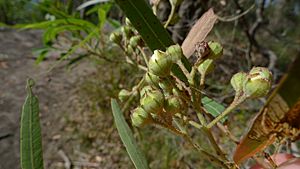Angophora bakeri subsp. bakeri facts for kids
Quick facts for kids Narrow-leaved apple |
|
|---|---|
 |
|
| Flower buds of Angophora bakeri in Jannali | |
| Scientific classification |
|
| Kingdom: | Plantae |
| Clade: | Tracheophytes |
| Clade: | Angiosperms |
| Clade: | Eudicots |
| Clade: | Rosids |
| Order: | Myrtales |
| Family: | Myrtaceae |
| Genus: | Angophora |
| Species: | |
| Subspecies: |
A. b. subsp. bakeri
|
| Trinomial name | |
| Angophora bakeri subsp. bakeri E.C.Hall
|
|
| Synonyms | |
Angophora bakeri subsp. bakeri, also called the narrow-leaved apple, is a tree found only in New South Wales, Australia. It's a small to medium-sized tree. This tree has rough bark on its trunk and branches. Its flowers are white or creamy white. They grow from buds in groups of three or seven. After flowering, it produces fruit shaped like a cup or barrel.
Contents
About the Narrow-Leaved Apple Tree
The narrow-leaved apple tree usually grows to be about 6 to 20 meters tall. It has a special woody swelling at its base called a lignotuber. This helps the tree regrow if it gets damaged, like by fire. The bark on its trunk and branches is rough and grey. It feels soft and fibrous.
Leaves of the Tree
Young plants and new shoots (called coppice regrowth) have long, narrow leaves. These leaves are about 50 to 100 mm long and 4 to 10 mm wide. They grow in pairs opposite each other on the stem.
Adult leaves are also in opposite pairs. They are thin and flexible. The top side is shiny green, and the bottom side is a dull pale green. These leaves are narrow and can be straight or slightly curved. They are usually 50 to 130 mm long and 5 to 15 mm wide. Each leaf has a short stalk, called a petiole, which is about 3 to 7 mm long.
Flowers and Fruit
The flower buds grow at the ends of the branches. They appear in groups of three or seven. Each group of buds sits on a main stalk, called a peduncle, which is 7 to 18 mm long. Each individual bud has its own smaller stalk, called a pedicel, about 4 to 11 mm long.
When the buds are ready, they are shaped like a globe. They are about 4 to 5 mm long and wide. You can see ribs running along their sides. The petals of the flowers are white with a green line down the middle. They are about 3 mm long and wide. These trees usually flower from December to February.
After the flowers, the tree produces fruit. The fruit is a capsule, which is a dry seed pod. It is shaped like a cup or a barrel. The fruit is about 7 to 10 mm long and 7 to 12 mm wide. It also has ribs along its sides. The parts that open to release the seeds are tucked inside the fruit.
How it Got its Name
The Angophora bakeri tree was first officially described in 1913. This was done by a person named Edwin Cuthbert Hall. Later, in 1986, Gregory John Leach looked closer at this tree. He described two different types, or subspecies, of Angophora bakeri. One of these was the subspecies bakeri, which is the one we are talking about. This information was published in a science journal called Telopea.
Where it Grows
This type of narrow-leaved apple tree likes to grow in sandy soil. This soil is usually found on sandstone rock formations. You can find it most often along the Central Coast of New South Wales.
There are also some groups of these trees that are separated from the main population. These are found north of Newcastle and as far south as Yalwal. Another group of these trees, which was once thought to be a different species, lives in the Gibraltar Range National Park.

